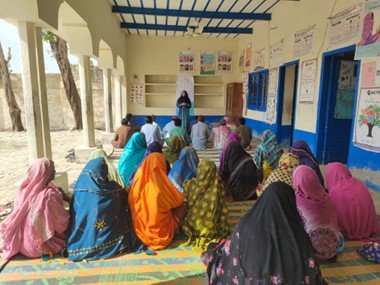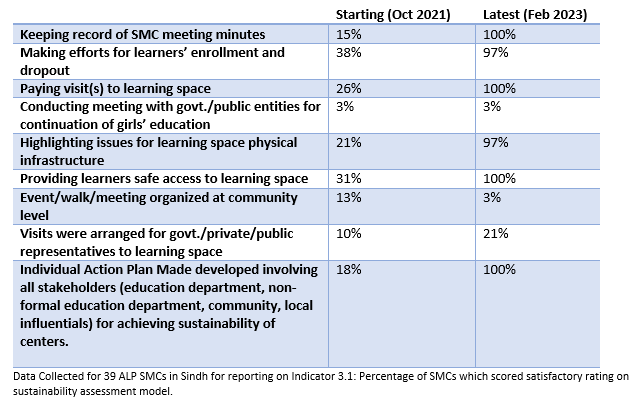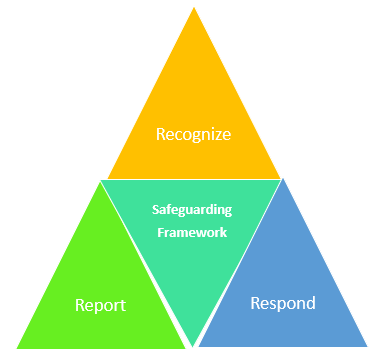When I joined the project Leave No Girl Behind (LNGB) back in 2021 as the Technical Advisor for Safeguarding and Child Protection, I was happy to see that a very strong safeguarding mechanism existed for both prevention and reporting of any incidents. The Foreign, Commonwealth and Development Office (FCDO, Foreign Secretary of the UK) and Girls Education Challenge Fund had a plethora of resources and materials to support their partners strengthening their institutional policies, practices and the safeguarding teams empowered organisations to deliver contextualized responses. From 2020 till 2023, there was one component that I felt was imperative to the success of Acted’s safeguarding and child protection framework: Space/School Management Committees (SMCs) comprising of community members.
Acted established SMCs for each location which consisted of local teachers, parents, influentials and in certain areas also included elders and members of Civil Society Organisations. Since the beginning of the project, LNGB team members ensured coordination with SMCs who were also sensitized on safeguarding, child protection, and Gender Equality and Social Inclusion (GESI) standards. SMC members were regularly oriented on Acted’s policies and reporting mechanisms by the Complaint Response Mechanism (CRM) teams and safeguarding focal points. They also had access to CRM boxes placed in the learning centers, as many centers were established in either the houses of community members or central locations. Specialized sessions were also delivered with the support of local CSO members in their native languages covering child protection, gender-based violence, child marriages and other forms of abuse.

Initially, we had no knowledge about protection, but after coming here, we learned what protection means. Before this, we never talked to our children about this matter
Evaluating the SMCs’ ability to create safe spaces
SMCs were evaluated on Maturity Indicators which reflected their ability and motivation to create a safe learning environment for the learners, teachers and the broader community. These indicators included advocating for the girl child’s rights to education, supporting conflict resolution, ensuring physical safety of learning center and mitigating any disciplinary issues in the learning center. Their levels of participation and satisfactory engagement on different components notably increased during the project period.
Table: Efficiency of SMCs at the beginning and at the end of the project period

SMC members and the broader community were able to provide support for the protection of learners and children – and their support was deemed essential at all stages of Acted’s safeguarding and child protection framework; Recognize, Report and Respond.

In practice: how SMCs facilitated community-led protection protection
Recognize
- As the communities are close knitted, parents who regularly engaged in SMCs, through meetings and attending training sessions, were noted to support girls’ education as advocates for inclusive behaviors in the broader community. In one instance, where a female learner was facing discrimination from her peers due to a disability was supported by not only her parents, but other parents from the community as well.
- Community members who regularly attended sensitization sessions arranged by Acted were also notably speaking out against any forms of child abuse and gender-based violence. We also had a case study where a father who decided to delay the marriage of his female child till the age of 18 to ensure continuation of her education, after speaking to the safeguarding team and SMC member.SMCs also encouraged men and boys to attend more of safeguarding and protection sessions, in addition to the GESI sessions that were already planned for them.
- Experts and CSOs also built the SMCs capacity to recognize concerns through awareness raising and participation in core referral committees. The circulation of Meri Hifazat, a book on child protection (Developed by Sahil) was a huge success and helped community members talk about different forms of child abuse. Sahil also supported delivery of sessions to mitigate the risks of GBV and child marriages in selected communities where there was a high reporting of protection cases.
Whatever I have learned at the center, I implement it in my family and guide my little sister. I share all the messages that I received from "Meri Hifazat" (My Protection) and the sessions on protection and safeguarding that take place here. I also participate in discussions with other learners at the center.
Report concerns through diversified channels
- SMC members were also reporting protection related concerns in the community, from any cases of abuse in families. A building owner, also an SMC member, reported a case of intimate partner violence as the learner approached the SMC member for support. The SMC member reported the concern via Acted CRM box and sought support for engaging the family with her. Some of them also reported (mostly anonymously via complaint boxes and hotlines) regarding any protection concerns existing within the broader community.
- Teachers were also involved in reporting cases of corporal punishment and bullying, mostly during visits of the safeguarding and CRM team, ensuring that a safe learning environment was created for everyone. Especially the teachers on the SMCs were taking ownership of the zero-tolerance policy , adapting positive behaviors and calling out unjust practices. Community members reported infrastructural concerns and contributed to updating safety audits by speaking to members of the team. Especially after the floods, when a rapid assessment of the locations was being conducted, the SMC members highlighted issues with boundary walls, broken floors and/or roofs and raised them through proper channels which allowed for quick action.
It was quite challenging to make people understand here that children can learn without being physically punished. People used to believe that only teachers are responsible for children's protection, but now they understand that child protection is everyone's responsibility
Respond to concerns and support follow-up actions
- Safeguarding team and community mobilizers were actively engaging the SMC members to ensure their involvement in effective running of the centers. Therefore, almost all SMCs were involved in response actions to protection concerns. Without sharing any sensitive information, the program team would also hold meetings on ad-hoc basis with targeted SMCs. Through either escorting children safely to the learning space or just having a simple conversation with another member of the community, SMC members mitigated and responded to risks of street harassment, child marriage, domestic violence, corporal punishment and bullying.
- Teachers and parents were trained on positive disciplining strategies and mental health psychosocial support strategies during sessions, and it was noted that they actively supported Acted staff, other teaching staff and the community members to overcome issues at home and the learning center.
- Building owners and SMC members participating in meetings also displayed more ownership of providing clean drinking water in the learning spaces, and quickly deploying human resources for restructuring of the learning spaces post-floods.
Therefore, based on the evaluation of project activities, feedback from the community and lessons learnt from case management; the establishment of SMCs was a successful initiative overall especially for ensuring safeguarding of the learning centers.
As development practitioners and humanitarian aid workers, we must understand that communities and affected populations are the most appropriate source to seek out knowledge and understanding of their own context. Compared to other actors, including INGOs, the communities are better suited to share an understanding of the protection risks and needs of their area and people. On the other hand, they are also aware of the challenges and gaps that exist in their capacity and resources allocated to them – which are required to address protection threats. They are also the ones who will be present (with or without any project!) making/breaking power structures, imparting their values, prescribing roles and responsibilities while holding each other accountable for behaviors – and eventually creating long-lasting impact on the lives of children and vulnerable groups.
Thus, community involvement and engagements whether through SMCs or any other community-led groups is necessary to establish and sustain a robust safeguarding and child protection mechanism. During this project, I realized how these communities deserve MORE recognition and resources for their role in protection whether as SMCs, families or simply as neighbors - and I hope one day we’re able to fully engage and empower them at local, national and international platforms